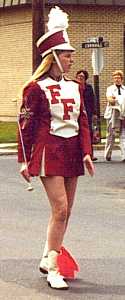|
|
|

|
Janie's Proud
Heritage Of Twirling And Marching |
People have twirled and marched for years.
Many parades have never been complete without majorettes strutting and twirling as they led the bands down the street.
Football games weren't complete without the half-time show featuring the marching band of at least one of the teams, or it's school, doing some sort of fancy drill that featured their twirlers/majorettes.
Schools have treated majorettes as an important part of their bands, and have, at least in some cases, asked that the girls maintain at least a certain level of academic achievement in order to keep on being majorettes. In those cases, if you saw a majorette marching with the school band, you knew that she was also a good student.
Majorettes have a long and proud heritage.
For many years, marching bands had been led on parade by a drum major. When young ladies started doing the drum major's duty during the 1920s and 1930s, their title was made more feminine by calling them "drum majorettes". That term is still very much in use, but did get shortened to just "majorette". Dictionaries will tell you that either term means a lady leading a band and twirling a baton.
|
|
|
|
|
Drum majorettes leading bands are part of our heritage. |
||
There are dictionaries that will tell you that the word "majorette" was in print by 1938. Life Magazine had a photo of two young majorettes on the cover of the October 10, 1938 issue. Anybody who wants to see it, can find it on Life's website. They have the means to see any Life cover you want.
In the 1950s, Life ran an article about a high school band which was sponsored on a trip to the island of Trinidad. The article included a large photo of one of the school's majorettes kissing a Trinidad girl who had been nice to her. Don't forget that this site is also about friendship.
Magazines and newspapers often ran photos of, and articles about, majorettes. They were almost always treated with respect and honor. Newspapers would honor a majorette who had won a twirling/majorette championship. Being a majorette was something worthwhile, and majorettes were ordinary people like anyone else. They could be young girls in the early years of their school education. They could be attending high school marching with the school band. They could also be young ladies who had finished school and were out there working next to the rest of us.
There has been lots of advertising -- TV, print, and posters -- featuring majorettes as mascots or users of whatever was being advertised. You just could not miss the majorette looking back at you from the advertising sign or the magazine page or the TV screen.
By the time the Life magazine cover photo of the majorettes had appeared in 1938, the majorette uniforms worn by most of them had, as part of it, either shorts or a short skirt. This was when short skirts were worn only in sports or entertainment, and long before the start of the miniskirt fashion. After miniskirts became a popular style, one magazine article was printed about a small town that was so conservative that the only "miniskirts" in town were worn by the majorettes. This was printed just below a photo of a high school band on parade.
Being a majorette comes from a proud heritage, and is a good heritage to be a part of.
[
Home
] [
Diane's Friendship Page
] [
Janie's Proud Heritage
] [
Ellen's Photo Page
] [
Wendy's Photo Page
]
[
Marla's History Page
} [
Michelle's Links Page
] [
Nancy's Message Board
]